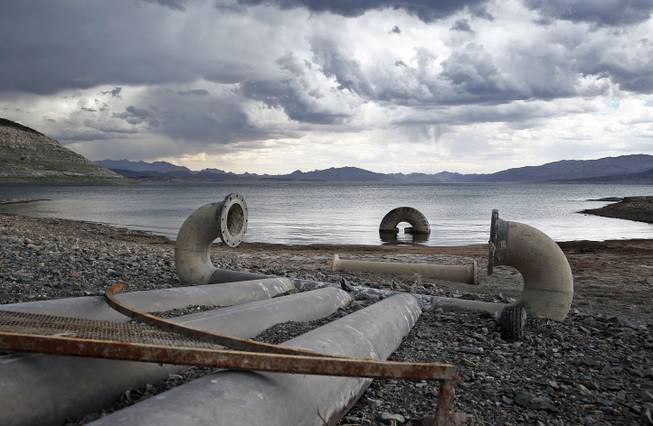
John Locher / AP
Water intake pipes that were once underwater sit above the water line along Lake Mead in Lake Mead National Recreation Area on Monday, May 18, 2015, near Boulder City.
Tuesday, Feb. 2, 2016 | 2 a.m.
Related news
If Southern Nevada’s water supply were a bank account, it still would be solvent — for now.
Here’s why: Nevada receives 300,000 acre-feet of water from the Colorado River each year, according to the Law of the River compacts, which govern distribution of the water among seven states and Mexico. Southern Nevada currently uses about 220,000 acre-feet of that allotment, leaving an 80,000-acre-feet buffer, said Bronson Mack, spokesman for the Southern Nevada Water Authority.
To put that into perspective, an acre-foot of water equals about 325,851 gallons, which is enough to supply two average-size Las Vegas homes for more than a year.
But there’s another magic number when it comes to Southern Nevada’s water supply — and that’s the water level, or “elevation,” of Lake Mead. Whenever the reservoir’s elevation falls to 1,075 feet and stays that way through Jan. 1 of the next year, the region’s yearly allotment of water from the Colorado River will be cut by roughly 4.3 percent.
Protecting Southern Nevada's water supply is one of several challenges facing experts who will gather Wednesday in Las Vegas for a second conference in what's been coined the "Week of Water," a two-event set of discussions aimed at helping avoid water crises here and in regions across the globe. Wednesday's event, the Las Vegas Water Summit, is sponsored by the Jewish National Fund and will be held at UNLV. (See full schedule below.) It comes after experts met Friday for a conference presented by Boyd Law School, Saltman Center for Conflict Resolution, Desert Research Institute and Brookings Institution.
The conferences are occurring amid a time when Lake Mead's water level is being watched especially closely. It’s far from an exact science, but the Bureau of Reclamation predicts Lake Mead’s elevation could drop to 1,074 feet in December 2017, triggering a water cut in 2018. Lake Mead ended last year with an elevation of 1,080 feet, according to the Bureau’s 24-month study released earlier this month. The lake’s elevation steadily has dropped since the onset of the severe drought 16 years ago that’s affecting the Colorado River Basin.
If the water cut would occur, Mack said it wasn't cause for panic: “It’s almost a little too early to say the sky is falling.”
Nevada would receive 287,000 acre-feet of water, still well above its current usage amount, he said. Plus, Nevada banks its unused water in Arizona, California and a groundwater aquifer here.
The real concern occurs when Lake Mead’s water level falls to 1,025 feet — the point at which the region would face a water cut totaling 20,000 acre-feet.
Even so, Mack touted the region’s success reducing water usage despite the population boom through programs such as giving customers rebates for installing water-smart landscaping. The Southern Nevada Water Authority also has partnered with several other water agencies — Denver Water, the Metropolitan Water District of Southern California and the Central Arizona Project — to work on conservation projects involving agriculture, water reuse and lining of canals, he said.
“The water agencies that are sharing in the Colorado River are taking some very progressive steps to ensure the health of the water system,” he said.
Water authorities also are closely watching the Mother Nature factor — snowmelt in the Rocky Mountains, which provides water to the Colorado River, and the regional effects of El Niño brewing in the Pacific Ocean.
Snowmelt runoff for Lake Powell, the other large reservoir along the Colorado River, is projected to be 89 percent of average, according to the National Weather Service’s Colorado River Basin Forecast Center.
El Niño-related storms tend to benefit Southern Nevada by recharging aquifers and filling lakes and streams, but water authorities said the full impact was too early to tell.
“Even a really great year wouldn’t undo the 16 years of drought,” said Rose Davis, spokeswoman for the Bureau of Reclamation’s Lower Colorado Region. “We just have to continue forward like it’s not going to get better.”
• • •
Las Vegas Water Summit
9 a.m. to 4 p.m. Wednesday
Stan Fulton Building, UNLV
Presented by Jewish National Fund
• Keynote speaker: Seth M. Siegel, author of "Let There Be Water: Israel's Solution for a Water-Starved World"
• Speakers: Russell Robinson, CEO, Jewish National Fund; Steve Hill, executive director, Nevada Governor's Office of Economic Development; Yaki Lopez, consul for political affairs, Consulate General of Israel in Los Angeles
• Host: Shelley Berkley, CEO and senior provost, Touro University
• Moderators: Pat Mulroy, senior fellow for climate adaptation and environmental policy, Brookings Institution/Boyd Law School, and Nathan Allen, executive director, Nevada’s Water Center of Excellence
• Panelists: David L. Johnson, deputy general manager, engineering/operations, LVVWD/SNWA; Jason Wuliger, co-founder and vice president of SplashLink.com; Steve Parrish, P.E., general manager/chief engineer, Clark County Regional Flood Control District; Cindy Ortega, senior vice president and chief sustainability officer, MGM Resorts International.
Registration: $45, jnf.org

Join the Discussion:
Check this out for a full explanation of our conversion to the LiveFyre commenting system and instructions on how to sign up for an account.
Full comments policy